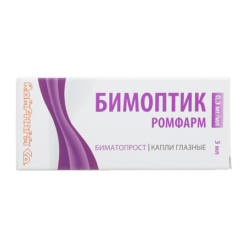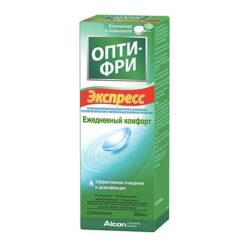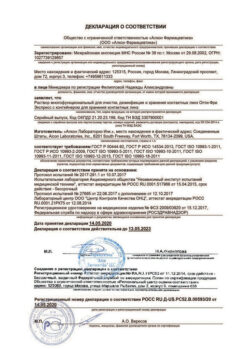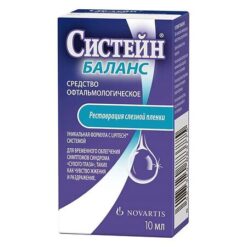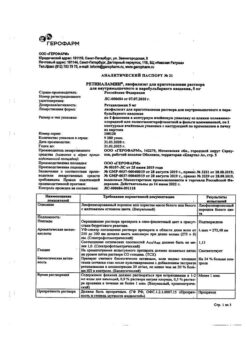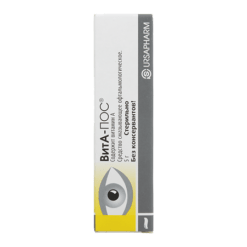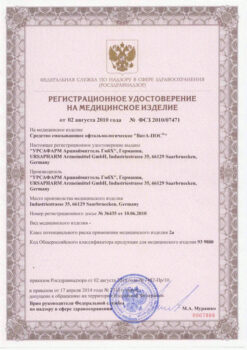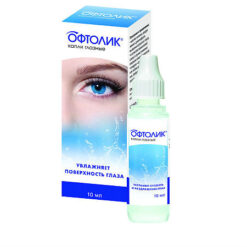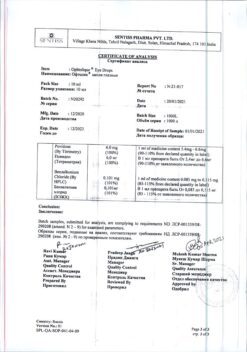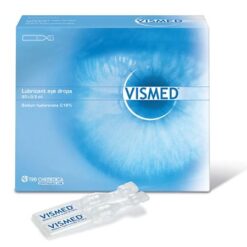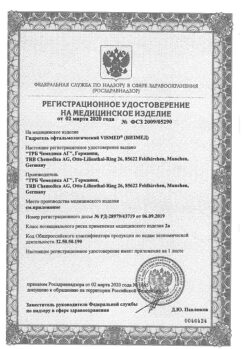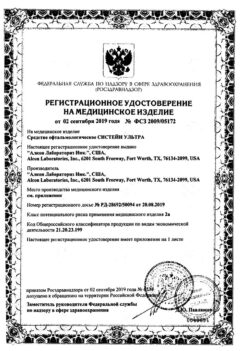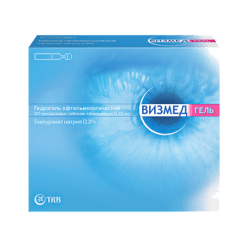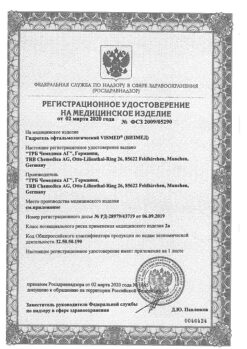No products in the cart.
Bimoptik Plus, eye drops 0.3 mg+5 mg/ml 3 ml
€20.11 €18.72
Description
Pharmacotherapeutic group: Antiglaucoma combined agent (prostaglandin F2-alpha analog synthetic + beta-adrenoblocker).
ATX code: S01ED51
Pharmacological properties
.Pharmacodynamics
The drug BIMOPTIC PLUS is a combination medicine. Its constituents bimatoprost and timolol lower intraocular pressure (IOP) through a synergistic interaction, resulting in a significantly more pronounced hypotensive effect compared to the effect of each component alone.
Bimatoprost is a synthetic prostamide with a chemical structure similar to prostaglandin F2-alpha (PGF2α). Bimatoprost has no effect on any of the known types of prostaglandin receptors. The hypotensive effect of bimatoprost is achieved by enhancing the outflow of intraocular fluid through the trabecula and through the uveoscleral pathway of the eye.
Timolol is a non-selective beta-adrenoblocker and has no intrinsic sympathomimetic and membrane-stabilizing activity.
Timolol reduces IOP by reducing the formation of intraocular fluid. The exact mechanism of action is not known; it may be related to inhibition of cyclic adenosine monophosphate (c-AMP) synthesis and is caused by endogenous stimulation of beta-adrenergic receptors.
pharmacokinetics
.Fixed combinationbimatoprost+timolol
Systemic absorption bimatoprost+timolol is minimal, not different with either combination treatment or instillation of each component of the drug alone.
Two 12-month studies showed no systemic cumulation of either active ingredient.
Bimatoprost
Absorption
Bimatoprost has been shown in in vitro studies to penetrate the iris and sclera. When instillation of 0.03% bimatoprost solution 1 drop in both eyes once a day for 2 weeks the maximum concentration (Cmax) of bimatoprost in plasma is reached within 10 minutes after application, and within 1.5 hours its concentration in plasma decreases to the lower limit of determination (0.025 ng/ml). The mean Cmax and area under the concentration-time curve (AUC0-24 h) of bimatoprost were close on days 7 and 14 of administration, and were 0.08 ng/mL and
0.09 ng*h/mL respectively, indicating that the equilibrium concentration of bimatoprost is reached within the first week of use.
Distribution
Bimatoprost is moderately distributed in the tissues, and the systemic volume of distribution when the equilibrium concentration of the drug is reached is 0.67 L/kg. Bimatoprost is predominantly found in blood plasma. Bimatoprost binding to plasma proteins is approximately 88%.
Metabolism
Bimatoprost undergoes oxidation, N-deethylation and glucuronidation to form various metabolites.
Elimation
Bimatoprost is excreted primarily by the kidneys. About 67% of the drug administered intravenously to healthy volunteers was excreted by the kidneys and 25% was excreted through the intestine. The half-life (T1/2) of bimatoprost, determined after intravenous administration, was approximately 45 minutes; and total clearance was 1.5 L/h/kg.
In elderly patients
When bimatoprost is administered twice daily, the mean AUC0-24 h in elderly patients is 0.0634 ng*h/ml, which is significantly higher than 0.0218 ng*h/ml in healthy young adults.
However, this difference has no clinical significance because the systemic exposure of bimatoprost to topical administration in elderly patients and healthy young adults is very low. There is no cumulation of bimatoprost in the systemic circulation and the safety profile does not differ between elderly patients and young adults.
Timolol
absorption and distribution
. In patients undergoing cataract surgery, after instillation of eye drops as a 0.5% solution, the Cmax of timolol in intraocular fluid after
1 h was 898 ng/mL. Some timolol enters the systemic bloodstream. Timolol is slightly bound to plasma proteins.
Metabolism
Timololol that enters the systemic bloodstream is metabolized in the liver.
Evolution
The T1/2 thymolol is about 4 to 6 h. Part of timolol metabolized in the liver is excreted through the intestine, and the other part and metabolites are excreted by the kidneys.
Indications
Indications
Reduction of intraocular pressure (IOP) in patients with open-angle glaucoma and intraocular hypertension with insufficient effectiveness of local use of beta-blockers and prostaglandin analogues.
Pharmacological effect
Pharmacological effect
Pharmacotherapeutic group: Combined antiglaucoma agent (synthetic prostaglandin F2-alpha analogue + beta-blocker).
ATX code: S01ED51
Pharmacological properties
Pharmacodynamics
The drug BIMOPTIC PLUS is a combination drug. Bimatoprost and timolol, which are part of it, reduce intraocular pressure (IOP) due to a combined interaction, leading to a significantly more pronounced hypotensive effect compared to the effect of each component separately.
Bimatoprost is a synthetic prostamid, similar in chemical structure to prostaglandin F2-alpha (PGF2α). Bimatoprost does not affect any of the known types of prostaglandin receptors. The hypotensive effect of bimatoprost is due to increased outflow of intraocular fluid through the trabecula and along the uveoscleral pathway of the eye.
Timolol is a non-selective beta-blocker and does not have intrinsic sympathomimetic or membrane-stabilizing activity.
Timolol reduces IOP by reducing the formation of intraocular fluid. The exact mechanism of action has not been established; it may be associated with inhibition of the synthesis of cyclic adenosine monophosphate (c-AMP) and is caused by endogenous stimulation of beta-adrenergic receptors.
Pharmacokinetics
Fixed combination of bimatoprost + timolol
Systemic absorption of bimatoprost + timolol is minimal and does not differ either with combined treatment or with instillation of each component of the drug separately.
In two studies lasting 12 months, no systemic accumulation of any of the active substances was observed.
Bimatoprost
Absorption
In vitro studies have shown that bimatoprost penetrates the iris and sclera. When instilling a 0.03% solution of bimatoprost, 1 drop into both eyes once a day for 2 weeks, the maximum concentration (Cmax) of bimatoprost in the blood plasma is achieved within 10 minutes after application, and within 1.5 hours its concentration in the blood plasma decreases to the lower limit of detection (0.025 ng/ml). The average values of Cmax and area under the concentration-time curve (AUC0-24 h) of bimatoprost were close on the 7th and 14th days of use, and amounted to 0.08 ng/ml and
0.09 ng*h/ml, respectively, indicating that the equilibrium concentration of bimatoprost is achieved during the first week of use.
Distribution
Bimatoprost is moderately distributed in tissues, and the systemic volume of distribution when the drug reaches equilibrium concentration is 0.67 l/kg. Bimatoprost is found predominantly in blood plasma. The binding of bimatoprost to plasma proteins is approximately 88%.
Metabolism
Bimatoprost undergoes oxidation, N-deethylation and glucuronidation to form various metabolites.
Removal
Bimatoprost is excreted primarily by the kidneys. About 67% of the drug administered intravenously to healthy volunteers was excreted by the kidneys, and 25% was excreted through the intestines. The half-life (T1/2) of bimatoprost, determined after intravenous administration, was approximately 45 minutes; and the total clearance is 1.5 l/h/kg.
In elderly patients
When using bimatoprost 2 times a day, the average value of AUC0-24 hours in elderly patients is 0.0634 ng*h/ml, which significantly exceeds the value of this indicator in healthy young individuals – 0.0218 ng*h/ml.
However, this difference is not clinically significant, since the systemic exposure of bimatoprost when applied topically in elderly patients and healthy young individuals remains very low. Cumulation of bimatoprost in the systemic circulation is not observed, the safety profile does not differ in elderly patients and young people.
Timolol
Suction and distribution
In patients who underwent surgical treatment of cataracts, after instillation of eye drops in the form of a 0.5% solution, Cmax of timolol in the intraocular fluid through
1 hour was 898 ng/ml. A certain amount of timolol enters the systemic circulation. Timolol is slightly bound to plasma proteins.
Metabolism
Timolol that enters the systemic circulation is metabolized in the liver.
Removal
T1/2 of timolol is about 4 – 6 hours. Part of timolol, which has been metabolized in the liver, is excreted through the intestines, and the other part and metabolites are excreted by the kidneys.
Special instructions
Special instructions
Just like other ophthalmic drugs, BIMOPTIC PLUS can penetrate into the systemic circulation. Due to the presence of timolol, a beta-adrenergic component, various types of adverse reactions (from the cardiovascular, respiratory and other systems) may be observed, as with the use of systemic beta-blockers. The incidence of adverse reactions with topical use of the drug is lower than with systemic use.
Cardiovascular system
Patients with cardiovascular disease (such as coronary artery disease, Prinzmetal’s angina and heart failure) and on antihypertensive therapy with beta-blockers should be critically evaluated and the use of other drugs should be considered. Monitoring of patients with cardiovascular disease is necessary to monitor for signs of worsening of these diseases and adverse reactions.
Patients with severe peripheral circulatory disorders (for example, severe forms of Raynaud’s disease or Raynaud’s syndrome) should use the drug with caution.
Respiratory system
Respiratory reactions, including death due to bronchospasm, have been reported in patients with asthma following use of certain ophthalmic beta-blockers.
Endocrine system
Beta blockers can mask the symptoms of hypoglycemia and hyperthyroidism.
Other beta blockers
Timolol may affect IOP or enhance the effect of systemic beta-blockers in patients already receiving a systemic beta-blocker. Close monitoring of such patients is recommended. Also, the use of two local beta-blockers is not recommended.
Anaphylactic reactions
In patients with a history of atopic manifestations and severe anaphylactic reactions to various allergens, doses of epinephrine (adrenaline), which are usually used to relieve anaphylactic reactions, may not be effective when using beta-blockers.
Choroidal detachment
Cases of choroidal detachment have been reported with the use of therapy that reduces the flow of intraocular fluid (eg, timolol, acetazolamide) after filtration surgery.
Surgical anesthesia
Ophthalmic drugs with beta-blocking activity may inhibit the systemic effects of beta-agonists such as epinephrine (adrenaline). It is necessary to warn the anesthesiologist about the patient’s use of timolol.
Liver function
In patients with mild liver disease or baseline elevated liver enzymes alanine aminotransferase (ALT), aspartate aminotransferase (AST) and/or total bilirubin, bimatoprost had no effect on liver function over a study period of more than 24 months.
There are no data on adverse reactions due to the effect of timolol on liver function.
Organ of vision
Before starting treatment, patients should be informed about the possible growth of eyelashes, increased pigmentation of the skin of the eyelids and pigmentation of the iris, since these side effects were established during studies of bimatoprost and the fixed combination of bimatoprost + timolol. Some changes may be permanent, and may be accompanied by differences between eyes if the drug is instilled in only one eye. After discontinuation of the drug BIMOPTIC PLUS, pigmentation of the iris may remain permanent. After 12 months of treatment with a fixed combination of bimatoprost + timolol, the incidence of iris pigmentation was noted in 0.2% of patients. And after 12 months of treatment with only bimatoprost in the form of eye drops 1.5%, a further increase in the frequency of this effect was not observed during therapy lasting 3 years.
Increased pigmentation of the iris is due to increased production of melanocytes, and not simply an increase in their number.
The duration of development of the effect of increased pigmentation of the iris is unknown. The change in color of the iris observed with the use of bimatoprost may not be pronounced over a period of several months to several years. The use of the drug does not affect nevi or pigment deposits on the iris of the eye. Periorbital pigmentation has been reported to be reversible in some patients.
A change in refraction is possible (due to discontinuation of therapy with miotic agents in some cases).
Leather
Hair growth is possible on those areas of the skin where the drug was accidentally applied. It is important to use the drug BIMOPTIC PLUS strictly in accordance with the instructions for medical use and not allow the drug to come into contact with the skin.
Excipients
The excipient benzalkonium chloride, which is part of the drug BIMOPTIC PLUS, can cause irritation of the mucous membrane of the eyes and discoloration of soft contact lenses. Contact lenses must be removed before administering the drug; they can be put on 15 minutes after instillation. Benzalkonium chloride may cause acute keratitis and/or toxic corneal ulcer. In this regard, it is necessary to monitor the patient’s condition during frequent or prolonged treatment with BIMOPTIC PLUS in persons with dry eye syndrome and with changes in the cornea.
After opening the bottle, the possibility of microbial contamination of its contents cannot be ruled out, which can lead to inflammatory eye lesions. The shelf life of the drug after first opening the bottle is 28 days. After the specified time has expired, the bottle should be discarded, even if the solution is not completely used.
It is recommended to write down the date the bottle was opened on the cardboard package of the medicinal product.
Impact on the ability to drive vehicles and machinery
There may be a transient deterioration in vision after administration of the drug, so the patient should wait until vision is completely restored before starting to drive vehicles and machinery.
Active ingredient
Active ingredient
Bimatoprost, Timolol
Composition
Composition
Composition per 1 ml of the drug:
Active ingredients: bimatoprost – 0.30 mg, timolol maleate (6.80 mg) in terms of timolol – 5.00 mg;
Excipients: citric acid monohydrate – 0.14 mg, sodium hydrogen phosphate heptahydrate – 2.68 mg, sodium chloride – 6.80 mg, benzalkonium chloride – 0.05 mg, 1 M sodium hydroxide solution or 1 M hydrochloric acid solution to pH 7.3 + 0.1, purified water – up to 1.00 ml.
Pregnancy
Pregnancy
Pregnancy
There are no adequate data on the use of the fixed combination of bimatoprost + timolol in pregnant women. The drug BIMOPTIC PLUS during pregnancy should be used only in cases where the expected benefit to the mother outweighs the potential risk to the fetus. Adequate and strictly controlled studies of the fixed combination of bimatoprost + timolol in pregnant women have not been conducted.
Animal studies have provided data on reproductive toxicity at high doses of bimatoprost.
Epidemiological studies have not revealed congenital malformations of the fetus, but have established the risk of intrauterine growth retardation when taking beta-blocker drugs orally. In cases where patients took a beta-blocker before delivery, the neonates experienced clinical symptoms characteristic of this group of drugs (for example, bradycardia, hypotension, respiratory distress syndrome and hypoglycemia).
In the case of using the drug BIMOPTIC PLUS until birth, it is necessary to monitor the condition of the newborn during the first days of life.
Animal studies have shown reproductive toxicity of timolol at doses significantly higher than those prescribed in clinical practice. Therefore, BIMOPTIC PLUS should not be used during pregnancy, unless absolutely necessary.
Breastfeeding period
Beta blockers pass into breast milk. However, when timolol is used in the form of eye drops in therapeutic doses, the development of clinical symptoms in children is unlikely, due to the lack of sufficient amounts of the drug in breast milk.
It is unknown whether bimatoprost passes into breast milk in humans, but it has been found to be present in the milk of lactating rats. The drug BIMOPTIC PLUS should not be used in women during breastfeeding.
Contraindications
Contraindications
Hypersensitivity to the components of the drug;
Syndrome of increased reactivity of the respiratory tract, including bronchial asthma in the acute stage and previous episodes in history; severe chronic obstructive pulmonary disease (COPD);
Sinus bradycardia, sick sinus syndrome, sinoauricular block, atrioventricular block II and III degrees without an implanted artificial heart pacemaker, clinically significant heart failure, cardiogenic shock;
Age up to 18 years.
With caution
Impaired liver and kidney function (the drug has not been sufficiently studied in this category of patients).
In patients with risk factors for macular edema (for example, aphakia, pseudophakia, rupture of the posterior lens capsule, as well as intraocular surgery, retinal vein occlusion, inflammatory eye diseases and diabetic retinopathy).
In patients with active intraocular inflammation (eg, uveitis), as inflammation may increase.
In patients with mild to moderate COPD, and only in cases where the expected benefit outweighs the possible risk.
In patients with first degree atrioventricular block due to a negative effect on intracardiac conduction time.
In patients with corneal diseases, since it can induce dry eye syndrome.
In patients with diabetes mellitus (unstable course) and impaired glucose tolerance, since the beta-blocker timolol, which is part of the drug BIMOPTIC PLUS, can mask the signs of hypoglycemia.
In patients with inflammatory changes in the eyes; neovascular, inflammatory, angle-closure glaucoma, congenital glaucoma (no data on efficacy and safety studies).
Side Effects
Side Effects
Security Profile Summary
Adverse reactions observed during clinical trials of the drug bimatoprost + timolol with a preservative were limited to those previously noted with the separate use of bimatoprost and timolol. Most of the adverse reactions observed in clinical studies were mild ocular reactions and none were serious. According to a 12-month clinical study, when using the drug bimatoprost + timolol with a preservative, the most common adverse reaction was conjunctival hyperemia (in most cases, mild and non-inflammatory in nature), which was observed in approximately 26% of patients, and was also the cause of treatment discontinuation in 1.5% of patients.
Adverse reactions are presented below according to organ involvement, organ systems and frequency of occurrence.
The frequency of occurrence of adverse reactions is determined as follows:
very often (> 1/10), often (> 1/100 and < 1/10), infrequently (> 1/1000 and < 1/100), rarely
(≥ 1/10000 and <1/1000), very rare (<1/10000), frequency unknown (frequency cannot be determined from available data).
Immune system disorders:
Reaction frequency unknown: hypersensitivity reactions including signs or symptoms of allergic dermatitis, angioedema, allergic eye reactions.
Mental disorders:
Frequency unknown: insomnia, nightmares.
Nervous system disorders:
Common: headache, dizziness.
Frequency unknown: dysgeusia.
Visual disorders:
Very common: conjunctival hyperemia.
Common: pinpoint keratitis, corneal erosion, burning sensation, itching in the eyes, tingling sensation in the eyes, foreign body sensation, dry eyes, redness of the eyelids, eye pain, photophobia, discharge from the eyes, blurred vision, itching of the skin of the eyelids, decreased visual acuity, blepharitis, swelling of the eyelids, irritation of the mucous membrane of the eyes, increased lacrimation, eyelash growth.
Uncommon: iridocyclitis, conjunctival edema, eyelid tenderness, asthenopia, trichiasis, iris hyperpigmentation, deepening of the eyelid crease, eyelid retraction.
Frequency unknown: cystoid macular edema, ocular swelling, blurred vision.
Cardiac disorders:
Frequency unknown: bradycardia.
Respiratory system disorders:
Often: rhinitis.
Uncommon: dyspnea.
Not known: bronchospasm (mainly in patients with existing bronchospastic disease), asthma.
Skin and subcutaneous tissue disorders
Common: eyelid skin pigmentation, hirsutism, skin hyperpigmentation (periocular).
Frequency unknown: alopecia.
General disorders and disorders at the injection site:
Frequency unknown: fatigue.
Like other locally applied ophthalmic drugs, the drug BIMOPTIC PLUS (bimatoprost/timolol) is absorbed into the systemic circulation.
The absorption of timolol may cause unwanted effects similar to those of systemic beta-blocking agents. The number of systemic adverse reactions after topical use is lower than after systemic use.
Other adverse reactions that were observed when using each of the components of the drug (bimatoprost or timolol) and potentially possible during treatment with BIMOPTIC PLUS:
Immune system disorders:
Systemic allergic reactions, including anaphylaxis1.
Metabolic and nutritional disorders: hypoglycemia1.
Mental disorders: depression1, memory loss1.
Nervous system disorders: fainting1, acute cerebrovascular accident1, increased signs and symptoms of myasthenia gravis1, paresthesia1, cerebral ischemia1.
Violations of the organ of vision: decreased sensitivity of the cornea1, diplopia1, ptosis1, choroidal detachment (after surgical treatment of glaucoma)1, keratitis1, blepharospasm2, retinal hemorrhage2, uveitis2.
Cardiac disorders: atrioventricular block1, cardiac arrest1, cardiac arrhythmias1, heart failure1, congestive heart failure1, chest pain1, palpitations1, edema1.
Vascular disorders: decreased blood pressure1, increased blood pressure2, Raynaud’s syndrome1, cold extremities1.
Disorders of the respiratory system, chest and mediastinal organs: exacerbation of asthma2, exacerbation of COPD2, cough1.
Gastrointestinal disorders: nausea1,2, diarrhea1, dyspepsia1, dry mouth1, abdominal pain1, vomiting1.
Skin and subcutaneous tissue disorders: psoriasis-like rash1 or exacerbation of psoriasis1, skin rash1.
Musculoskeletal and connective tissue disorders: muscle pain1.
Disorders of the genital organs and breast: sexual dysfunction1, decreased libido1.
General disorders and disorders at the injection site: asthenia1,2.
Laboratory and instrumental data:
Changes in liver enzyme activity2.
1 adverse reactions noted during timolol therapy
2 adverse reactions noted during bimatoprost therapy
Adverse reactions to phosphate-containing eye drops
Very rare cases of corneal calcification have been reported when used concomitantly with phosphate-containing eye drops in some patients with significant corneal damage.
Interaction
Interaction
No special studies have been conducted to study drug interactions with the fixed combination of bimatoprost + timolol.
It is possible to potentiate the effects of combined use of ophthalmic solutions of beta-blockers and ingested blockers of “slow” calcium channels, guanethidine, beta-blockers, parasympathomimetics, antiarrhythmic drugs (including amiodarone) and cardiac glycosides, which was manifested by a decrease in blood pressure and/or severe bradycardia.
Potentiation of the systemic effects of beta-blockers (eg, decreased heart rate, depression) has been reported when timolol is co-administered with CYP2D6 inhibitors (quinidine, fluoxetine, paroxetine).
Cases of mydriasis have been occasionally reported with the concomitant use of ophthalmic beta-blockers and adrenaline (epinephrine).
Patients using BIMOPTIC PLUS with other prostaglandin analogues should be monitored for changes in IOP.
Very rare cases of corneal calcification have been reported when used concomitantly with phosphate-containing eye drops in some patients with significant corneal damage.
Overdose
Overdose
When administering the drug BIMOPTIC PLUS, an overdose is unlikely or may be associated with toxic effects.
Bimatoprost
In case of unintentional ingestion of bimatoprost + timolol, the following information may be useful: there were no symptoms of toxic effects of bimatoprost in doses up to 100 mg/kg/day during 2 weeks of oral administration in experiments on rats and mice. The dose used in the study, expressed in mg/m2, is 70 times higher than the possible dose of bimatoprost if the contents of a vial containing bimatoprost + timolol were accidentally ingested by a child weighing 10 kg.
Timolol
In case of an overdose of timolol, the following symptoms may be observed: bradycardia, decreased blood pressure, bronchospasm, headache, dizziness, shortness of breath, cardiac arrest. Studies have shown that timolol is not completely eliminated by hemodialysis. If an overdose occurs, symptomatic therapy is necessary.
Storage conditions
Storage conditions
At a temperature not exceeding 25 °C, in the original packaging.
Keep out of the reach of children.
Shelf life
Shelf life
3 years.
After opening the bottle, the drops should be used within 4 weeks.
Do not use after the expiration date stated on the package.
Manufacturer
Manufacturer
K.O.Rompharm Company S.R.L., Romania
Additional information
| Shelf life | 3 years. After opening the bottle the drops should be used within 4 weeks. Do not use after the expiration date stated on the package. |
|---|---|
| Conditions of storage | At the temperature not more than 25 °С, in the original package. Keep out of reach of children. |
| Manufacturer | C.O.Rompharm Company S.R.L., Romania |
| Medication form | eye drops |
| Brand | C.O.Rompharm Company S.R.L. |
Other forms…
Related products
Buy Bimoptik Plus, eye drops 0.3 mg+5 mg/ml 3 ml with delivery to USA, UK, Europe and over 120 other countries.


